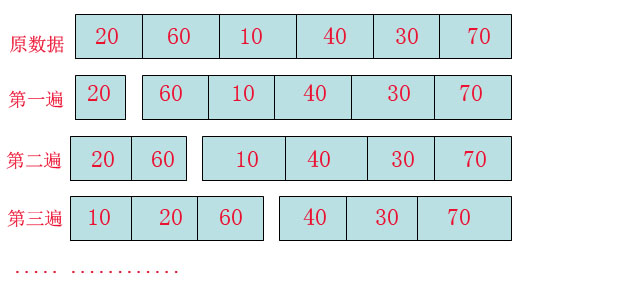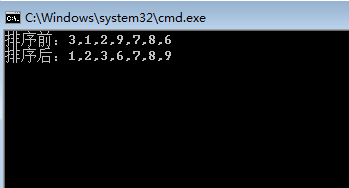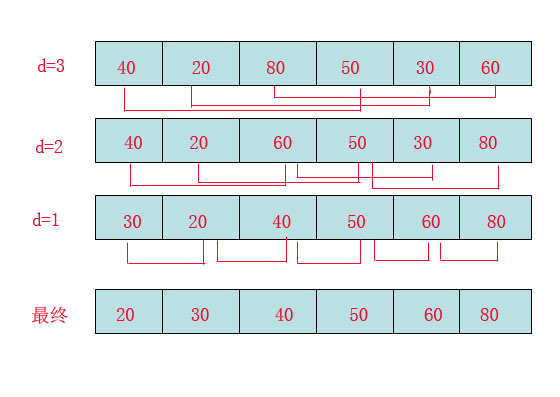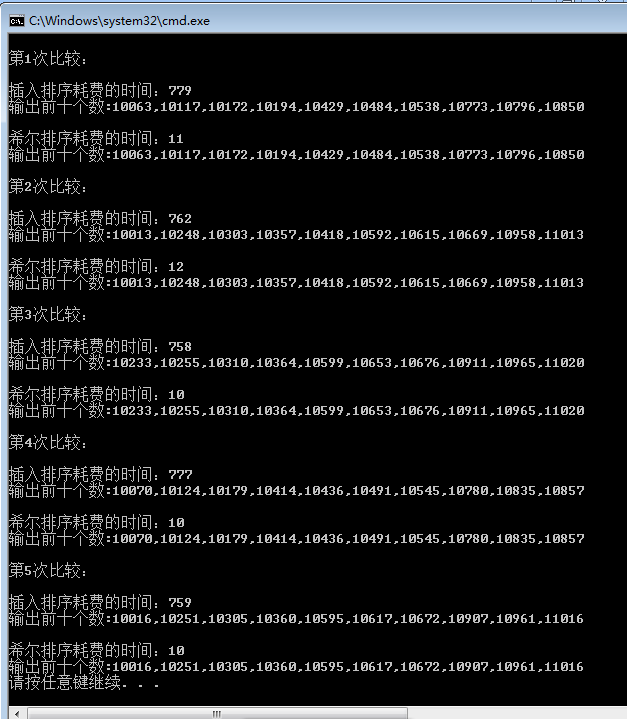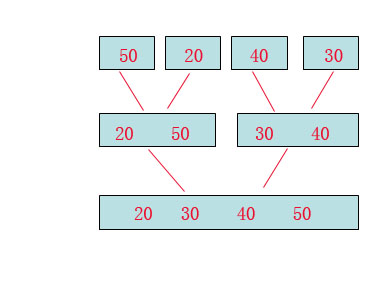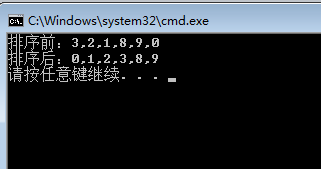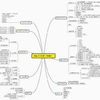今天跟大家聊聊最后三种排序: 直接插入排序,希尔排序和归并排序。
直接插入排序:
这种排序其实蛮好理解的,很现实的例子就是俺们斗地主,当我们抓到一手乱牌时,我们就要按照大小梳理扑克,30秒后,
扑克梳理完毕,4条3,5条s,哇塞...... 回忆一下,俺们当时是怎么梳理的。
最左一张牌是3,第二张牌是5,第三张牌又是3,赶紧插到第一张牌后面去,第四张牌又是3,大喜,赶紧插到第二张后面去,
第五张牌又是3,狂喜,哈哈,一门炮就这样产生了。
怎么样,生活中处处都是算法,早已经融入我们的生活和血液。
下面就上图说明:
看这张图不知道大家可否理解了,在插入排序中,数组会被划分为两种,“有序数组块”和“无序数组块”,
对的,第一遍的时候从”无序数组块“中提取一个数20作为有序数组块。
第二遍的时候从”无序数组块“中提取一个数60有序的放到”有序数组块中“,也就是20,60。
第三遍的时候同理,不同的是发现10比有序数组的值都小,因此20,60位置后移,腾出一个位置让10插入。
然后按照这种规律就可以全部插入完毕。
1 using System;
2 using System.Collections.Generic;
3 using System.Linq;
4 using System.Text;
5
6 namespace InsertSort
7 {
8 public class Program
9 {
10 static void Main(string[] args)
11 {
12 List<int> list = new List<int>() { 3, 1, 2, 9, 7, 8, 6 };
13
14 Console.WriteLine("排序前:" + string.Join(",", list));
15
16 InsertSort(list);
17
18 Console.WriteLine("排序后:" + string.Join(",", list));
19 }
20
21 static void InsertSort(List<int> list)
22 {
23 //无须序列
24 for (int i = 1; i < list.Count; i++)
25 {
26 var temp = list[i];
27
28 int j;
29
30 //有序序列
31 for (j = i - 1; j >= 0 && temp < list[j]; j--)
32 {
33 list[j + 1] = list[j];
34 }
35 list[j + 1] = temp;
36 }
37 }
38 }
39 }
希尔排序:
观察一下”插入排序“:其实不难发现她有个缺点:
如果当数据是”5, 4, 3, 2, 1“的时候,此时我们将“无序块”中的记录插入到“有序块”时,估计俺们要崩盘,
每次插入都要移动位置,此时插入排序的效率可想而知。
shell根据这个弱点进行了算法改进,融入了一种叫做“缩小增量排序法”的思想,其实也蛮简单的,不过有点注意的就是:
增量不是乱取,而是有规律可循的。
首先要明确一下增量的取法:
第一次增量的取法为: d=count/2;
第二次增量的取法为: d=(count/2)/2;
最后一直到: d=1;
看上图观测的现象为:
d=3时:将40跟50比,因50大,不交换。
将20跟30比,因30大,不交换。
将80跟60比,因60小,交换。
d=2时:将40跟60比,不交换,拿60跟30比交换,此时交换后的30又比前面的40小,又要将40和30交换,如上图。
将20跟50比,不交换,继续将50跟80比,不交换。
d=1时:这时就是前面讲的插入排序了,不过此时的序列已经差不多有序了,所以给插入排序带来了很大的性能提高。
既然说“希尔排序”是“插入排序”的改进版,那么我们就要比一下,在1w个数字中,到底能快多少?
下面进行一下测试:

1 using System;
2 using System.Collections.Generic;
3 using System.Linq;
4 using System.Text;
5 using System.Threading;
6 using System.Diagnostics;
7
8 namespace ShellSort
9 {
10 public class Program
11 {
12 static void Main(string[] args)
13 {
14 //5次比较
15 for (int i = 1; i <= 5; i++)
16 {
17 List<int> list = new List<int>();
18
19 //插入1w个随机数到数组中
20 for (int j = 0; j < 10000; j++)
21 {
22 Thread.Sleep(1);
23 list.Add(new Random((int)DateTime.Now.Ticks).Next(10000, 1000000));
24 }
25
26 List<int> list2 = new List<int>();
27 list2.AddRange(list);
28
29 Console.WriteLine("\n第" + i + "次比较:");
30
31 Stopwatch watch = new Stopwatch();
32
33 watch.Start();
34 InsertSort(list);
35 watch.Stop();
36
37 Console.WriteLine("\n插入排序耗费的时间:" + watch.ElapsedMilliseconds);
38 Console.WriteLine("输出前十个数:" + string.Join(",", list.Take(10).ToList()));
39
40 watch.Restart();
41 ShellSort(list2);
42 watch.Stop();
43
44 Console.WriteLine("\n希尔排序耗费的时间:" + watch.ElapsedMilliseconds);
45 Console.WriteLine("输出前十个数:" + string.Join(",", list2.Take(10).ToList()));
46
47 }
48 }
49
50 ///<summary>
51 /// 希尔排序
52 ///</summary>
53 ///<param name="list"></param>
54 static void ShellSort(List<int> list)
55 {
56 //取增量
57 int step = list.Count / 2;
58
59 while (step >= 1)
60 {
61 //无须序列
62 for (int i = step; i < list.Count; i++)
63 {
64 var temp = list[i];
65
66 int j;
67
68 //有序序列
69 for (j = i - step; j >= 0 && temp < list[j]; j = j - step)
70 {
71 list[j + step] = list[j];
72 }
73 list[j + step] = temp;
74 }
75 step = step / 2;
76 }
77 }
78
79 ///<summary>
80 /// 插入排序
81 ///</summary>
82 ///<param name="list"></param>
83 static void InsertSort(List<int> list)
84 {
85 //无须序列
86 for (int i = 1; i < list.Count; i++)
87 {
88 var temp = list[i];
89
90 int j;
91
92 //有序序列
93 for (j = i - 1; j >= 0 && temp < list[j]; j--)
94 {
95 list[j + 1] = list[j];
96 }
97 list[j + 1] = temp;
98 }
99 }
100 }
101 }
截图如下:
看的出来,希尔排序优化了不少,w级别的排序中,相差70几倍哇。
归并排序:
个人感觉,我们能容易看的懂的排序基本上都是O (n^2),比较难看懂的基本上都是N(LogN),所以归并排序也是比较难理解的,尤其是在代码
编写上,本人就是搞了一下午才搞出来,嘻嘻。
首先看图:
归并排序中中两件事情要做:
第一: “分”, 就是将数组尽可能的分,一直分到原子级别。
第二: “并”,将原子级别的数两两合并排序,最后产生结果。
代码:
1 using System;
2 using System.Collections.Generic;
3 using System.Linq;
4 using System.Text;
5
6 namespace MergeSort
7 {
8 class Program
9 {
10 static void Main(string[] args)
11 {
12 int[] array = { 3, 2, 1, 8, 9, 0 };
13
14 MergeSort(array, new int[array.Length], 0, array.Length - 1);
15
16 Console.WriteLine(string.Join(",", array));
17 }
18
19 ///<summary>
20 /// 数组的划分
21 ///</summary>
22 ///<param name="array">待排序数组</param>
23 ///<param name="temparray">临时存放数组</param>
24 ///<param name="left">序列段的开始位置,</param>
25 ///<param name="right">序列段的结束位置</param>
26 static void MergeSort(int[] array, int[] temparray, int left, int right)
27 {
28 if (left < right)
29 {
30 //取分割位置
31 int middle = (left + right) / 2;
32
33 //递归划分数组左序列
34 MergeSort(array, temparray, left, middle);
35
36 //递归划分数组右序列
37 MergeSort(array, temparray, middle + 1, right);
38
39 //数组合并操作
40 Merge(array, temparray, left, middle + 1, right);
41 }
42 }
43
44 ///<summary>
45 /// 数组的两两合并操作
46 ///</summary>
47 ///<param name="array">待排序数组</param>
48 ///<param name="temparray">临时数组</param>
49 ///<param name="left">第一个区间段开始位置</param>
50 ///<param name="middle">第二个区间的开始位置</param>
51 ///<param name="right">第二个区间段结束位置</param>
52 static void Merge(int[] array, int[] temparray, int left, int middle, int right)
53 {
54 //左指针尾
55 int leftEnd = middle - 1;
56
57 //右指针头
58 int rightStart = middle;
59
60 //临时数组的下标
61 int tempIndex = left;
62
63 //数组合并后的length长度
64 int tempLength = right - left + 1;
65
66 //先循环两个区间段都没有结束的情况
67 while ((left <= leftEnd) && (rightStart <= right))
68 {
69 //如果发现有序列大,则将此数放入临时数组
70 if (array[left] < array[rightStart])
71 temparray[tempIndex++] = array[left++];
72 else
73 temparray[tempIndex++] = array[rightStart++];
74 }
75
76 //判断左序列是否结束
77 while (left <= leftEnd)
78 temparray[tempIndex++] = array[left++];
79
80 //判断右序列是否结束
81 while (rightStart <= right)
82 temparray[tempIndex++] = array[rightStart++];
83
84 //交换数据
85 for (int i = 0; i < tempLength; i++)
86 {
87 array[right] = temparray[right];
88 right--;
89 }
90 }
91 }
92 }结果图:
ps: 插入排序的时间复杂度为:O(N^2)
希尔排序的时间复杂度为:平均为:O(N^3/2)
最坏: O(N^2)
归并排序时间复杂度为: O(NlogN)
空间复杂度为: O(N)
共同学习,写下你的评论
评论加载中...
作者其他优质文章


